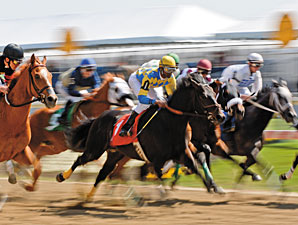2014 Equine Race Fatality Rate Mirrors 2013

The Jockey Club has released equine race fatality year-over-year statistics comparing 2013 and 2014 and a six-year summary of statistics collected from the Equine Injury Database that shows the incidence of fatal equine race injury for 2014 of 1.89 per 1,000 starts was down ever so slightly from the 1.90 per 1,000 starts rate in 2013.
Dr. Tim Parkin, a veterinarian and epidemiologist from the University of Glasgow who serves as a consultant on the Equine Injury Database, performed the analysis.
"In 2014, the incidence of fatal injury on turf increased 27% after showing a 20% decrease in the prior year; however, the incidence of fatal injury decreased 3.8% on dirt and 1.6% on synthetic over 2013," Parkin said.
The prevalence of race-related fatal injury for the six-year timeframe from January 1, 2009, through December 31, 2014, was 1.91 per 1,000 starts. The data is based on analysis of 2,180,443 starts.
When comparing race distance, shorter races (less than six furlongs) saw a slightly higher injury rate compared with middle (six-furlong to one mile) and long races (more than a mile). This is consistent each year over the six-year span.
Similar to prior years, 2-year-olds continued the trend of the lowest rate of catastrophic injuries. However, unlike four of the previous five years, in 2014, 3-year-olds had a higher rate of catastrophic injuries than horses 4 years old and older.
The statistics include only race injuries that resulted in fatalities within 72 hours from the date of the race. Summary statistics are subject to change because of a number of considerations.
A list of racetracks participating in the Equine Injury Database and detailed statistics from those tracks that voluntarily publish their results can be found here.
The Equine Injury Database, conceived at the Grayson-Jockey Club Research Foundation's first Welfare and Safety of the Racehorse Summit, was launched by The Jockey Club in July 2008 and seeks to identify the frequency, types, and outcome of racing injuries using a standardized format that generates valid statistics, identifies markers for horses at increased risk of injury, and serves as a data source for research directed at improving safety and preventing injuries.
